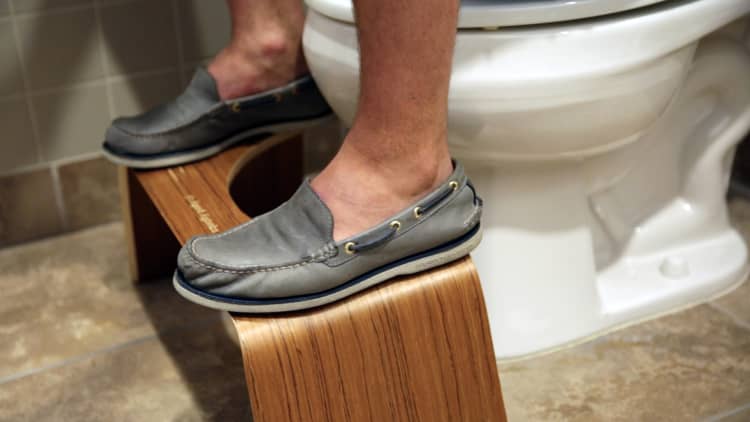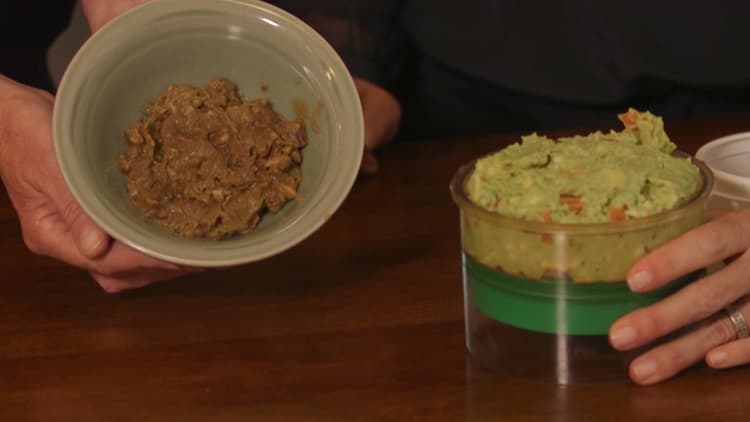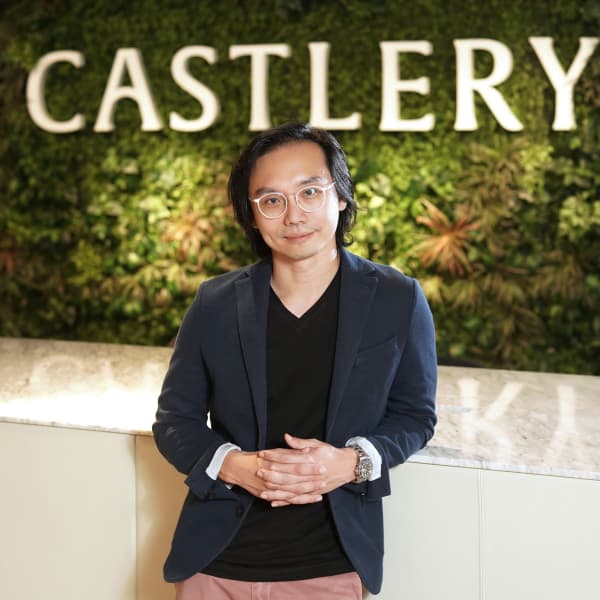"If we can do it, anybody can do it," said Jane Och, co-founder of Guac-Lock.
Guac-Lock is a storage container that solves one of America's biggest party problems: keeping guacamole from turning brown. After four difficult years of product development, it launched in 2016 and is already on track for $1 million in sales this year.
"If we can do it, anybody can do it," repeated her friend and co-founder Sharon Prince. (The two founders do a lot of repeating and finishing each other's sentences.)
Hey, guess what??? "Strange Success" is now a podcast! From doomsday bunkers to guac-savers (stay tuned -- that episode is coming up Jan. 31), you will learn about a whole lot of strange successes by subscribing to the podcast. You can listen to it free on Apple podcasts! Click here to get started.
Both women started their professional careers as investment managers and then switched to raising children while still doing consulting work. They met through their kids, became good friends and then stepsisters (more on that later), and finally became empty nesters.
Then they got bored.
One day in 2012, Och was in her kitchen taking a container of guacamole out of the fridge when she commented on how fresh it looked unopened, even though it had been in there for days.
"I realized if I don't touch this container of guacamole, it will never turn brown," she said. "The second I put a chip in it, there's space. So I thought if somehow we could eliminate that space, then we've maybe solved this age-old problem."
Prince agreed. "Guacamole was becoming so popular, avocados were coming more and more into style. ... Let's try and solve the problem!"
People try all kinds of ways to keep guacamole looking green — keeping the pit in the dip, which only seems to work for awhile, or putting water on top, which makes it kind of mushy.
As for an actual storage product that keeps the air out, Och and Prince figured someone had already made one.
"I kept Googling for months and months. I couldn't understand, there's no way somebody hadn't come up with this idea," said Och. "Sure enough, nobody had."
There's a reason for that. It's really hard. Solving this "age-old problem" took four years and cost each woman $100,000 of personal savings.
Neither Prince nor Och had ever invented anything. They knew nothing about engineering, manufacturing, branding, distributing or the need to get a patent. "We just started mentioning it to anybody we knew," said Prince.
The more people they asked, the more help they got. "I would listen to people's advice, and you never know where that's going to lead," Och added.
One of the first things they did was name the product, which turned out to be the only easy part of this journey. The name came up in a brainstorming session in Och's kitchen with her teenager daughter and friends. "We're just talking, 'Oh, PopLock, or Guac-It,'" she said.
Someone blurted out, "What about Guac-Lock?"
Prince knew immediately they had a winner. "Guac-Lock stuck very early on."
Prototyping Guac-Lock
An industrial designer they met through a friend created potential designs for the Guac-Lock that would be easy to use while pushing out all the air.
"We started with push-down containers, and literally, in the middle of the night, we had this epiphany," said Och. "I called Sharon, and I said, 'You know, if we push up, then as you push up, it always looks like a brand new ready-to-serve container!'"
Another friend connected them with the Chicago International Home and Housewares Show, and they had to create a prototype quickly.
"It turns out we found an amazing person through another friend of a friend, a prototype-making guy," said Och before Prince chimed in, "who produced them in FIVE DAYS in Taiwan," (then Och finished the sentence) "and literally five days to our door we had seven of these prototypes."
Testing the idea
They went to the housewares show in 2014, and Guac-Lock ended up as a finalist in the Innovation category. Suddenly their booth was very popular. However, they only had the prototype, not a real FDA-approved product.
"Everybody's coming by and saying, 'Well, how do we get them?'" said Prince. "'We said, 'We're not quite ready to ship, we're almost there. ... Why don't you give us your name and number and information and when we have them, we will contact you.'"
Even here, the network of friends paid off. "Before the housewares show — talk about people you know — a good friend of ours was at a shiva call and met this gentlemen," Och said. (A "shiva call" is a traditional period of mourning in Judaism.)
The gentleman was Bruce Kaminstein, founder of home products company Casabella. Kaminstein promised to help the two newbies. In fact, their booth at the show ended up near Casabella's massive display.
"He sent over his head of manufacturing, his head of branding sales, anybody that came by his booth that he felt could be helpful to us," said Prince. Och added, "He said, 'You know what? I was where you guys were one day, and I just want to help out.'"
Casabella even approached the two with a licensing agreement, allowing Guac-Lock to leverage the bigger company's contacts and distribution, while still leaving the two founders in charge of product development.
Good thing the two got that deal, because a lot went wrong.
Disaster strikes
The biggest problem was the material they first chose to make Guac-Lock. Everyone suggested silicone — "The wonder plastic!" both women said. Silicone is what a lot of storage products are made of, and it's FDA approved.
However, it has a fatal flaw for storing guacamole. "The main characteristic of silicone is gas permeability," said Och. Prince added, "Exactly what we did not want!"
The permeability allowed air to seep through to the guacamole, turning it brown. It took a very long time to figure this out. "Guacamole tells no lies," said Och. "We would just continue to test it with guacamole. ... The hundreds and hundreds of batches of guacamole we made, you can only imagine."
They finally hired a materials engineer who came up with a less permeable "thermoplastic elastomer." It took six months and a lot of money — "a very dark period" — but an FDA-approved elastomer was created. "We found this secret sauce, which everyone thinks is silicone, but it's not," said Och.
But wait, there's more.
A reinvention
"When you manufacture something, you need a draft angle," Och said. A draft angle means that the top opening of a product is ever so slightly smaller or larger than the bottom opening, allowing for quick removal from a manufacturing mold in mass production.
The original draft angle for the Guac-Lock had the smaller opening at the bottom, but as you pushed the guac up through the larger opening, some of the dip would slide down the sides of the pushing part. It essentially meant you could only push once, you couldn't continue to store the guacamole after one use, and it was kind of messy.
One night, Och had another epiphany. "I called Sharon in the middle of the night, I'm like, 'Sharon, I need you, I need you!'" She realized that if the smaller opening was at the top instead of the bottom, the guacamole would be pushed out without making a mess, and whatever remained could continue to be stored airtight until the next use. It was a much better product design.
But there was a huge problem. The first order of 12,000 Guac-Locks had already been produced in China and were about to ship out. Simply turning the device upside down wouldn't work. It would have to be re-engineered and manufactured. Both women called Casabella to stop the shipment and start a redesign. Och said everyone agreed her new idea was better, but they told her the old design was still good.
"We have 12,000, and they're going to market. ... We'll do it next time,'" Och said she was told. She would have none of it. "I turned to Sharon and I said — and she knew exactly what I was going to say — I just said, 'You know what? This is our baby, we've worked on it forever, and knowing that this greatly improves the product, I cannot come to market without making this improvement.'"
Casabella agreed to their demands. The two women found a temporary mold maker in Michigan, which quickly turned out the first 3,000 Guac-Locks they needed to meet immediate obligations, and the factory in China then reworked the mold to make the rest. Och and Prince covered the cost of the delay — $11,000.
Success at last
After all that time and money, Guac-Lock finally launched in 2016, four years after the idea came alive in Och's kitchen. The containers retail for $19.99, and a version that comes with a fitted chip tray sells for $29.99. First-year sales were $200,000, and 2017 is on track to do $1 million. The product is now sold everywhere from Amazon to Bed, Bath and Beyond, and the two women get a slice of unit sales.
They want to expand its use beyond guacamole to storing things like tuna salad, hummus or pesto. "Somebody even suggested the cannabis industry," said Och, laughing, before dismissing the idea ... sort of. "We could call it PotLock."
Perhaps most amazing, the pair are still best friends and, of course, sisters.
About 20 years ago, Och's father passed away around the same time as Prince's mother died. One time, when both surviving parents happened to be visiting their respective grandchildren, the widower noticed the widow at a Little League game.
"My dad called me and said, 'I saw this good-looking woman, I think she's the mother of your friend," said Prince. "I said, 'Dad, forget it.'"
He didn't forget it. The two met, fell in love, and married.
"Really great friends became siblings," said Prince. And then co-founders. "It really was meant to be," Och agreed.
Like this story? Like CNBC Make It on Facebook.
Don't Miss: How this entrepreneur went from a crack addict to a self-made multimillionaire







